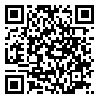دوره 12، شماره 4 - ( 8-1403 )
جلد 12 شماره 4 صفحات 384-377 |
برگشت به فهرست نسخه ها
Download citation:
BibTeX | RIS | EndNote | Medlars | ProCite | Reference Manager | RefWorks
Send citation to:



BibTeX | RIS | EndNote | Medlars | ProCite | Reference Manager | RefWorks
Send citation to:
Fallahinejad Ghajari M, Ansari G, Mohaveri M, Eghbali Zarch A, Razavi S. Sedative Effect of Nasal Midazolam-Ketamine at Different Doses on 3-6-year-old Uncooperative Dental Patients. J. Pediatr. Rev 2024; 12 (4) :377-384
URL: http://jpr.mazums.ac.ir/article-1-518-fa.html
URL: http://jpr.mazums.ac.ir/article-1-518-fa.html
Sedative Effect of Nasal Midazolam-Ketamine at Different Doses on 3-6-year-old Uncooperative Dental Patients. Journal of Pediatrics Review. 1403; 12 (4) :377-384
چکیده: (1849 مشاهده)
Background: Midazolam and ketamine, either alone or in combination, are safe and effective in intranasal application among dental sedation routes.
Objectives: This randomized clinical trial compares higher and lower-dose intranasal ketamine/midazolam cocktails in pediatric dentistry.
Methods: This double-blind randomized clinical trial was conducted on 20 uncooperative children aged 3-6 years with a definitely negative Frankel scale. The participants were divided into two groups. Group A received 0.4 mg/kg midazolam and 4 mg/kg ketamine nasally 20 min before initiating dental treatment in the first session while receiving 0.5 mg/kg midazolam/ 3 mg/kg ketamine in the second session. Meanwhile, group B received the opposite drug sequence to assess any sequence effect. Dental treatment was initiated with local anesthesia administration. The sedation score was recorded using the Houpt scale. Vital signs were recorded at every 10-min intervals along with potential side effects. The data were analyzed using variance analysis and Wilcoxon and McNemar tests.
Results: No significant differences were noted in vital signs between groups at recording intervals (anesthetic injecting [P=0.719], 10 min [P=0.317] and 20 min [P=0.480]). No reports were received on post-treatment nausea (P=0.289).
Conclusions: There was no indication of a significant difference between groups tested with different drug doses, in support of lower ketamine dose as an effective yet safer approach to treat children. The parents were satisfied with their child’s calmness through both episodes of treatment.
Objectives: This randomized clinical trial compares higher and lower-dose intranasal ketamine/midazolam cocktails in pediatric dentistry.
Methods: This double-blind randomized clinical trial was conducted on 20 uncooperative children aged 3-6 years with a definitely negative Frankel scale. The participants were divided into two groups. Group A received 0.4 mg/kg midazolam and 4 mg/kg ketamine nasally 20 min before initiating dental treatment in the first session while receiving 0.5 mg/kg midazolam/ 3 mg/kg ketamine in the second session. Meanwhile, group B received the opposite drug sequence to assess any sequence effect. Dental treatment was initiated with local anesthesia administration. The sedation score was recorded using the Houpt scale. Vital signs were recorded at every 10-min intervals along with potential side effects. The data were analyzed using variance analysis and Wilcoxon and McNemar tests.
Results: No significant differences were noted in vital signs between groups at recording intervals (anesthetic injecting [P=0.719], 10 min [P=0.317] and 20 min [P=0.480]). No reports were received on post-treatment nausea (P=0.289).
Conclusions: There was no indication of a significant difference between groups tested with different drug doses, in support of lower ketamine dose as an effective yet safer approach to treat children. The parents were satisfied with their child’s calmness through both episodes of treatment.
نوع مطالعه: Original Article |
دریافت: 1402/10/13 | پذیرش: 1402/12/28 | انتشار: 1403/7/10
دریافت: 1402/10/13 | پذیرش: 1402/12/28 | انتشار: 1403/7/10
| بازنشر اطلاعات | |
 |
این مقاله تحت شرایط Creative Commons Attribution-NonCommercial 4.0 International License قابل بازنشر است. |





